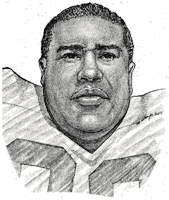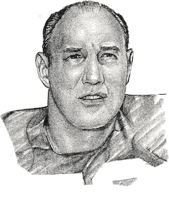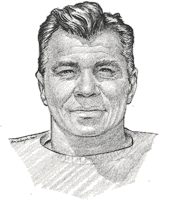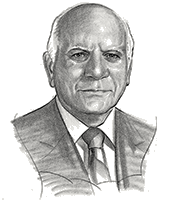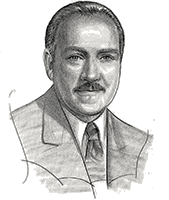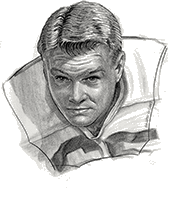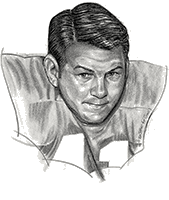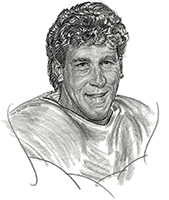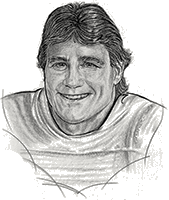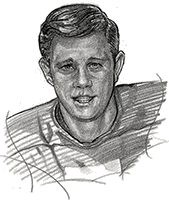Named to the Professional Football Hall of Fame in 1968. In an eight-year career with Cleveland Browns, beginning in 1946, he established himself as one of the great runners in pro history. Led Browns in rushing in six of his eight seasons, led team in scoring in 1949 and tied for leas in 1947. Averaged 5.7 yards per carry for his career, gaining a total of 4,712 yards. Was also an excellent defensive player. Named to the All-American Conference All-Pro teams from 1946-49 and to the National Football League All-Star Team in 1950.
An All-American tackle at the University of Kentucky he established himself as one of the finest defensive tackles in Cleveland Browns history during an illustrious career which lasted from 1952 through 1966. During that time he was named to the All-Pro team five times (in 1958-59-60-62 and 1963), played in six National Football League championship games and on the Browns’ World championship teams of 1954, 1955 and 1966. He was also honored by the Cleveland Touchdown Club as the “Defensive Player of the Year.”
A product of Cleveland South High and Ohio University, he started his professional career with Cleveland Rams, but elected to leave them to become a member of the Cleveland Browns when the All-American Conference was formed in 1946. Played for AAC championship teams in each of his three seasons with the Browns. A defensive tackle, he bulwarked a powerful line, which allowed the fewest points in the league in each of his three AAC seasons.
Deceased.
After a brilliant football career at Washington and Jefferson College capped by a Rose Bowl appearance in 1922, he mixed law studies and pro football while at the same time launching a coaching career that was to span three decades. St. Ignatius, John Carroll and University School were the recipients of his winning programs. He helped organize the “Big Four,” ushering in the golden era of local collegiate football.
A graduate of Cornell in 1916, he was a two time collegiate All-American. His professional career included playing for the Massillon Tigers, Cleveland Bulldogs, Akron Indians, and the Toledo Blades. He was the Tigers’ left end when they played Jim Thorpe and the Canton Bulldogs for the world title in 1919. The other Tigers end at that time was Knute Rockne of Notre Dame. Ladimir also helped in the establishment of the NFL Hall of Fame.
Football at Benedictine High School and the University of Dayton led to a seven year professional career with the Cleveland Browns as an offensive guard and linebacker. During his years with the Browns they won five divisional titles and played in three NFL title games (1953, 1954, 1955), winning two. Subsequently, as head coach of the Pittsburgh Steelers he led them to an unprecedented four Super Bowl titles.
After a distinguished football career at Shaw High School and Ohio State University, he went on to an eleven year professional career. Consistently among the leading rushers in the NFL, in 1965 he stepped in for ailing quarterback Johnny Unitas and, as the Colts’ “Instant Quarterback,” threw two touchdown passes to spark the victory over Los Angeles which then led to the memorable playoff game against Green Bay in which he again led the team as quarterback. He played in the Pro-Bowl in 1968 and 1969.
The son of Lakewood High School’s football coach was a good learner. So good that by the time he wound up an awesome career at neighboring St. Edward High in 1974 as an All-Ohio and All-American linebacker he had become one of the nation’s most coveted players. How coveted? On the night before the NCAA’s national letter signing day, three coaches gathered in the Cousineau home to do verbal battle for his signature. It was a gathering of legends: Bo Schembechler of Michigan, Joe Paterno of Penn State and Ohio State’s Woody Hayes. In a red letter day for the Scarlet and Gray, Hayes emerged a winner. Cousineau went on to win All-American honors in 1977 and 1978 (and a quarter-century later to be named the winner of the 2003 Butkus Silver Anniversary Award as the best linebacker in college football from 25 years ago). He would set an OSU season record with 211 tackles in 1978, take part in 29 tackles against Penn State, at the time another Buckeye mark with 16 solo tackles against Southern Methodist. At the end of his senior year he was selected by the Buffalo Bills, with the first pick in the 1979 NFL draft. Unable to reach a contract agreement, he opted to play for the Montreal Alouettes in the Canadian Football League where he became the Grey Cup MVP in 1979. The Bills traded his rights to the Cleveland Browns in 1983 and in five seasons with the Browns he led the team in tackles three times and was picked to two all-NFL teams. He ended his career with the San Francisco 49ers, retiring in 1987. In 2006, he announced his candidacy for a seat in the Ohio House of Representatives, won his primary and is currently Republican candidate for the seat.
What was earning first team all-ACC honors as a middle linebacker at the University of Virginia worth to Dick Ambrose? Selection in the 12th round of the 1975 NFL draft by the Cleveland Browns. What was Dick Ambrose worth to the Cleveland Browns for the next nine seasons? Priceless. The 6-0 235-pounder—who earned the nickname “Bam Bam” which he carried through his career when he broke a pair of shoulder pads while making a tackle in his rookie season—became a starter early on and retained that status, starting 64 consecutive games, until a broken leg sidelined him in the sixth game of the 1983 season. He led the team in tackles for five consecutive years from 1977 to 1981, was named the team’s most valuable defensive player in 1977, was an integral part of the storied “Kardiac Kids” in 1980 (a team which wrote a special page in the Browns’ history), was voted the winner of the Browns’ Captains Award made annually to “a team player and an inspiration” in 1981, and was elected a team co-captain in 1982. He began studying law while still an active player, and received his degree from Cleveland State’s Marshall College of Law in 1987 and practiced law in Cleveland until he was appointed a judge of the Cuyahoga County Court of Common Pleas in 2004. The native of New Rochelle, NY, has remained active in a large number of civic, charitable and athletic affairs in Greater Cleveland and makes his home in Westlake.
One of Greater Cleveland’s top high school athletes in the early ’60s, he climaxed a brilliant football career by quarterbacking St. Joseph High to a 9-0-1 record as a senior in 1963 to earn a spot on the All-Ohio team as selection as the area’s outstanding scholastic by the Cleveland Touchdown Club. Moving on to Notre Dame, he played quarterback as a sophomore, then was converted to safety for his final two seasons. As a defensive player, he gained All-American as a senior when he set several school records that were to stand for more than 25 years, including most interceptions returned for touchdowns and most yards gained on punt returns in a game and a season. He was drafted by the Cleveland browns in 1968, but a stint in the Army put his professional career on hold until 1970 when he put in one season with the Browns. After several years in the business world, he returned to St. Joseph as an assistant football coach in 1988. He became the Vikings’ head coach in 1995 and added the duties of the athletic director in 1998.
Deceased 2023
2001 Crocker Rd., Ste. 510, Westlake, OH 44145
Phone: 216-241-1919

